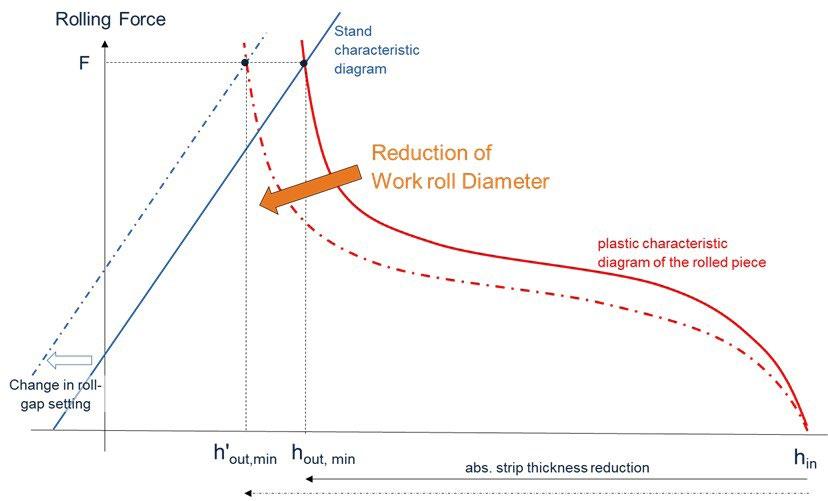
13 minute read
Pioneering Cold Rolling of AHSS and Electrical Steel
K. Krimpelstaetter, R. Kellermayr, M. Bergmann
Decarbonization activities are important to act effectively and sustainably against climate change. Especially the automobile industry triggers the development of Electrified Vehicles with light-weight design to reduce greenhouse gas emissions and carbon footprint over the vehicle’s entire life cycle. This in turn raises the demand for development of new steel grades with improved strength, like 3rd generation AHSS (Advanced High-Strength Steels), press hardened steels, martensitic steels and also thin-gauge high-permeability NGO (Non-Grain Oriented) electrical steels to improve the energy conversion efficiency of electrical motors.
While new high-end cold rolling mills meet the process requirements to produce these advanced steel grades, existing rolling facilities are predominantly not capable to introduce and provide these grades to the market.
Primetals Technologies is continuously developing and supporting its customers by offering innovative products and technologies to meet the high and quickly changing demands of the metals industry and its end customers. This paper introduces selected cold rolling innovation highlights, which are significantly contributing to a successful production of AHSS and electrical steel, while keeping quality and environmental standards high and operation costs on a competitive, low level.
The “HYPER UC-MILL®” is a new generation of 6-high cold mill with reduced work roll diameters, work roll drive and still high torque transmission capability. This technology is not only today’s role model for new tandem and reversing mills, but also an affordable solution for mill revamps. Its excellent reduction and shape control capability combined with reduced edge loads and straight roll inventory make the HYPER UC-MILL the perfect solution to produce highstrength steels and thin-gauge cold rolled products. Additional new features like strip temperature guidance (STG), edge-drop control (EDC) and Minimum Quantity Lubrication (MQL®) support a stable and reliable production of highgrade electrical steels with low waste and high yield.
STG ensures that the strip temperature during rolling is kept in a required operation window to improve formability and avoid strip overheating. MQL represents a new roll-gap lubrication technology with many advantages for rolling AHSS and electrical steel. In case of high-grade electrical steel or hard and brittle strip materials, MQL prevents a cool down of strip temperature, which may positively influence the formability and improve the rolling stability. EDC is a further beneficial technology to improve strip edge profile and consequently to reduce downstream trimming losses to get optimum lamination factors with low core loss of electrical steel.
KEYWORDS: COLD ROLLING, AHSS, NGO-EV, HYPER UC-MILL, MINIMUM QUANTITY LUBRICATION MQL, STRIP TEMPERATURE GUIDANCE STG, EDGE-DROP CONTROL EDC
Introduction
Carmakers are developing and producing Electrified Vehicles (EV) with light steel body structure, optimized designs and excellent crash behavior that reduce mass and therefore greenhouse gas emissions over the vehicle’s entire life cycle. This calls for new generations of advanced high-strength steels (AHSS) with high deformation resistance and
Primetals Technologies Austria GmbH, Austria - konrad. krimpelstaetter@primetals.com thinner product thicknesses. Additionally, there is a sustainable demand from carmakers for ultra-thin non-grain oriented electrical steels with 3.2 to 3.4% silicon and in a thickness range of 0.2 mm to 0.3 mm. These grades are frequently called NGO-EV and have demanding requirements concerning geometrical tolerances, surface quality, material strength, texture evolution as well as magnetic properties.
Electric traction motors consist of copper coils, permanent magnets, and steel core laminations. Steel core laminations are a stack of isotropic magnetic steel sheets, which are separated by a lacquer coat to achieve a high permeability and high magnetic induction.
A high-efficient energy conversion requires low core losses and high magnetization. Accordingly, future passenger cars exchange the combustion engine by highly efficient electric motors resulting in at least doubling the weight of silicon steel per car to approx. 60 – 90 kg / car (considering NGO-EV only, cf. [7]).
The trend to use more silicon steels in electrical appliances in the automotive industries motivates steel producers to invest in rolling mill equipment and automation solutions to modernize their existing production facilities.
In order to meet or even surpass today’s product quality levels, knowledge of the processes as well as the devices, machines and plants comprising these processes is essential.
In the past, cold rolling of silicon steel and special steel grades was mainly done in cold reversing mills because they offer high flexibility in terms of pass-schedule design. Nowadays, with increasing demand on higher volumes of AHSS and electrical steels, (continuous) tandem cold rolling mills are more and more used, because they offer higher productivity, higher yield and lower operating costs per produced ton of electrical steel. Cold rolling of high-silicon electrical steel is characterized by an increased risk for strip breaks. The main reason is due to the high brittleness of high-silicon steels at typical cold rolling temperatures. The high room temperature brittleness of the strip material in combination with high rolling loads (strip tension, contact pressure and shear stresses in the roll bite) during cold rolling can lead to generation and growth of edge cracks, which can lead to strip breaks, equipment damages and significant production downtimes and delays. Additional to the challenging production conditions, product quality (thickness, flatness and surface) is still of paramount importance. Tolerances for these criteria are constantly tightening, especially as the target delivery thicknesses dive to 0.2 mm and even below. Maximization of yield must go hand-in-hand with efficient use of process consumables. These requirements affect the mechanical, electrical and process design of the mills.
The mechanical rolling capability of an operating rolling mill is primarily determined by:
• Power of the main motors and tension levels (main drive, reels, bridle rolls)
• Available roll separating force (RSF)
• Mill stand stiffness
• Shape control capability
• Work roll diameter
• Roll-gap lubrication efficiency
Influence Of Work Roll Diameter
The effect of the work roll diameter can be demonstrated schematically in the gaugemeter diagram (also known as roll force/strip thickness diagram, cf. [3] or [5]) in Fig.1. Fig.1 shows the plastic characteristic (red solid line) and the minimum achievable exit thickness hout,min in case of a large work roll diameter and for an incoming strip thickness hin. Here the absolute strip thickness reduction is limited for the considered product in the specific pass. The rapid increase of rolling force at thinner exit thickness results from severe work roll flattening. The additional required energy transferred via the roll load cylinders is mainly wasted into elastic deformation of the work rolls. A reduction of work roll diameter shifts the plastic characteristic curve to the left side in Fig.1. As can be seen from this graph, reducing the work roll diameter (i.e. switching from red solid to red dashed curve in Fig.1) decreases the minimum achievable exit thickness h’out,min, mainly as a result of lower rolling forces and consequently reduced roll flattening. This allows for the production of lower strip exit thickness at comparable rolling force levels.
This phenomenon has been successfully utilized in cluster mills, as 20-high mills or Z-mills, to be able to produce stainless steel and special grades for many years. However, for the sake of completeness it needs to be stated that a further limitation of final gauge can arise due to kissing rolls outside the strip width.
Fig.1 - Gaugemeter diagram and the influence of reduced work roll diameter on rolling capability.
UCM-MILL AND STRIP EDGE PROFILE CONTROL
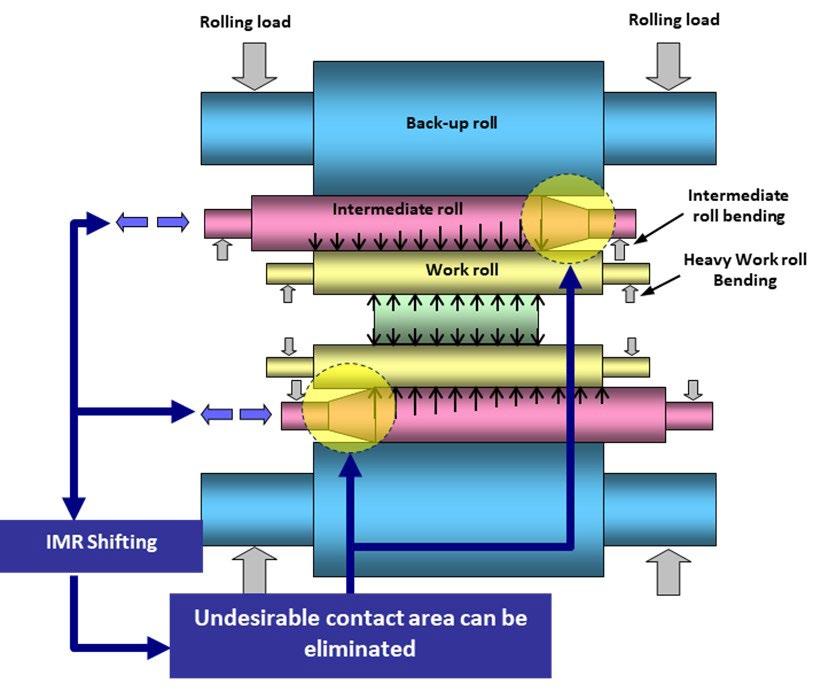
The work roll diameter of a 6-high Universal Crown Mill (UCM, cf. Fig.2) in range of 385 to 425 mm is widely used for AHSS and electrical steel production in tandem cold mill configuration. It is characterized by driven work rolls and an axially shiftable intermediate roll according to the actual strip width, together with the installed work roll and intermediate roll bending system. It is possible to utilize a cylindrical work roll shape to achieve a stable strip shape, which meets highest strip flatness requirements.
Fig.2 exhibits the advantages of a UC-Mill by eliminating the undesired contact area thanks to the tapered work roll design and the smart edge-oriented roll shifting, which also allows to achieve excellent shape controllability.
Fig.2 - Core design of Universal Crown Mill.
For cold rolling of hard material, the strip thickness profile decreases sharply at the edge area. This is called edge drop and is caused by longitudinal deviation of the work roll flattening. Especially for the production of electrical steel, less edge drop is essential to achieve high lamination factors and consequently low core losses.
To reduce the edge drop, a UCM-W Mill (cf. Fig.3), which has additionally a work roll shift mechanism, can be applied to a UCM-Mill.
Work rolls with a special chamfer are shifted by means of hydraulic cylinders provided in each shifting block at the drive side. Optimum roll gap profile with reduced edge drop is achieved by combining work roll shifting, intermediate roll shifting, work roll bending and intermediate roll bending. The work rolls with their chamfers are shifted in a way to ensure a pre-defined edge-up control. Edge drop control (EDC) is most efficient in the first stands of a tandem cold rolling mill.
Fig.3 - Core design of Universal Crown Mill.
HYPER UC-MILL
The most beneficial mill stand technology for producing the upper range of AHSS and high-grade NGO electrical steel represents the 6-high Hyper Universal Crown Control Mill (HYPER UC-Mill), which is a further development of the well-established UCM technology.
Although the UCM-mill is capable of processing lower range AHSS and middle grade electrical steel in a 5-stand configuration, the growing demand for harder AHSS and thinner electrical steels with high silicon content led to the development of the HYPER UC-Mill (cf. also [2]). In order to apply smaller diameter work rolls to a TCM, a comprehensive study of the influence of work roll diameter on the shape control capability, Hertzian Stress between rolls and the reduction ratio was carried out. The study focused on the reduction capacity of the tandem mill. Rolling loads can be reduced and higher reduction ratios can be obtained by using work rolls with smaller diameters. This study showed that the highest reduction ratio is achieved with work rolls having a diameter app. 20-40% smaller than those of the standard UC-Mill.
Under the above-described limitations, the optimum work roll diameter was found in a range of 230 mm to 290 mm for a HYPER UC-Mill with a maximum width of app.
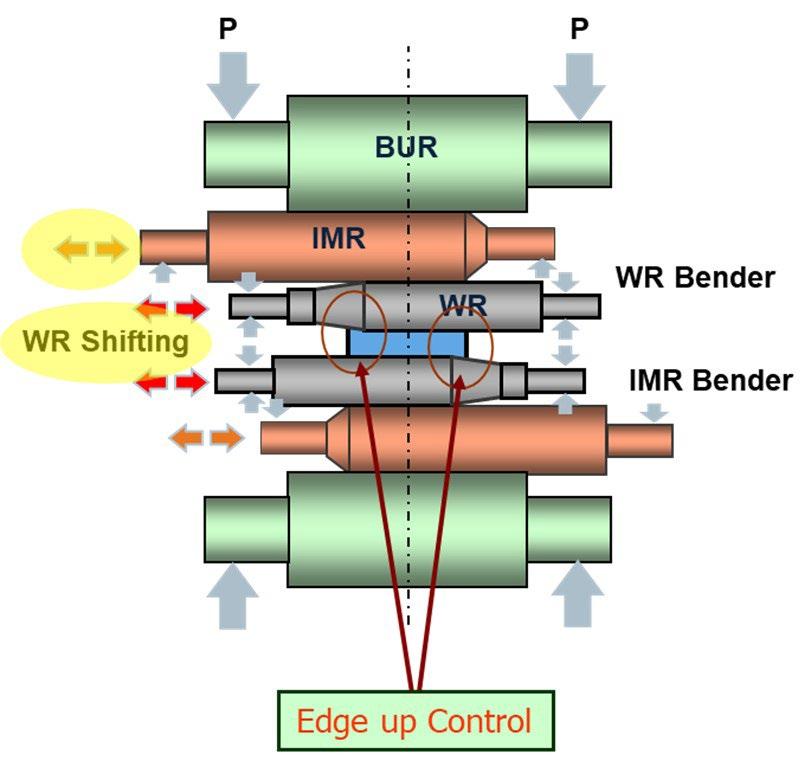
1300 mm (4 feet).
While decreasing the work roll diameter, it was necessary to increase the intermediate roll diameter to ensure mill stability for highest shape controllability.
A new gear-type spindle capable of transmitting higher torque with small diameter work rolls was also developed. This technology called “New MH-Spindle” can transmit 2.7 times the torque of a conventional Universal Joint (UJ)type spindle (cf. Fig.4).
Fig.4 - New MH-Spindle of HYPER UC-Mill.
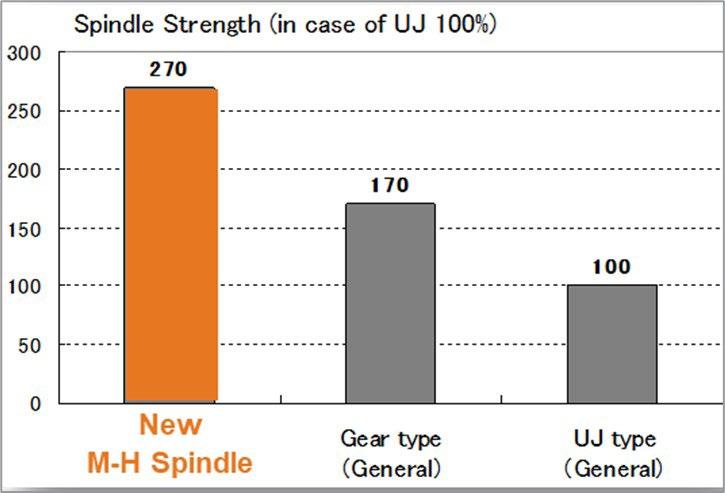
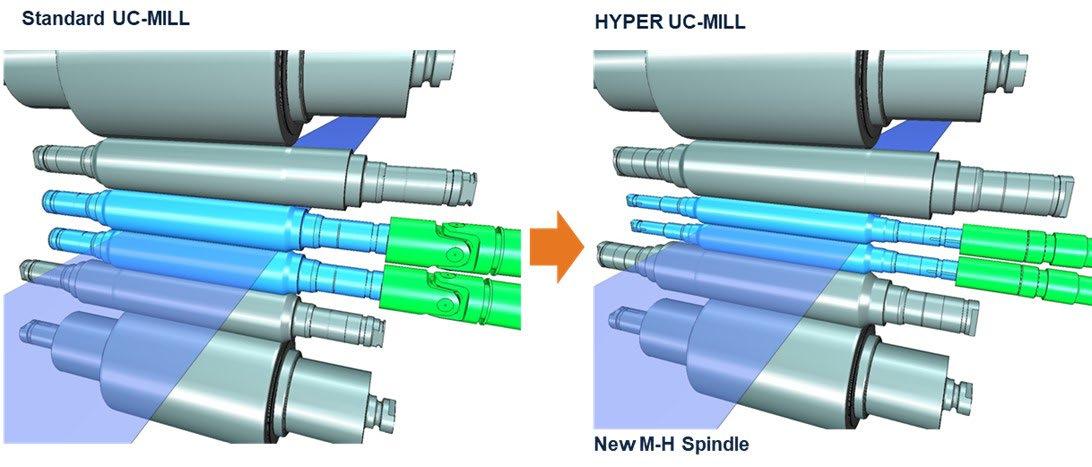
As a result, the HYPER UC-Mill was introduced as a new rolling mill type, which uses smaller work rolls and high strength spindles to enable rolling of high-strength materials and high-grade electrical steels.
Fig.5 shows a visual comparison of roll arrangements between standard UC-Mill and HYPER UC-Mill. To keep the highest shape controllability also in case of reduced work roll diameter for the HYPER UC-Mill, the intermediate roll diameter is increased accordingly.
One of the latest references of a HYPER UC-MILL is shown in Fig.6, which was especially designed to produce high- permeability non-grain oriented (NGO) electrical steel and advanced high-strength steels (AHSS). The reversing mill features a twin-stand 6-high HYPER UC-MILL with driven work rolls and new MH-spindles for highest torque transmission. The mill is equipped with Minimum Quantity Lubrication MQL® and an inductive strip heating system.
Fig.5 -Roll arrangement of Standard UCM and HYPER UCM.
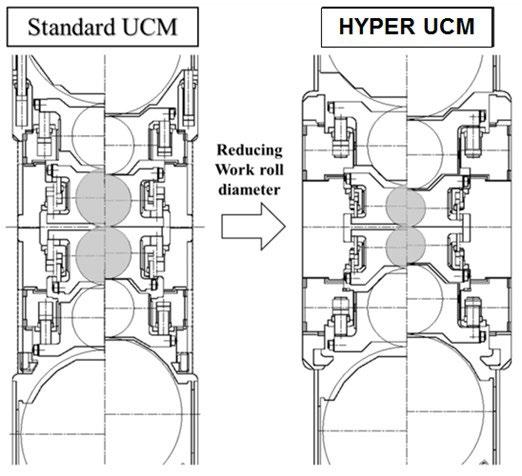
Fig.6 - 2-stand HYPER UCM-Mill for the production of HNGO and AHSS.
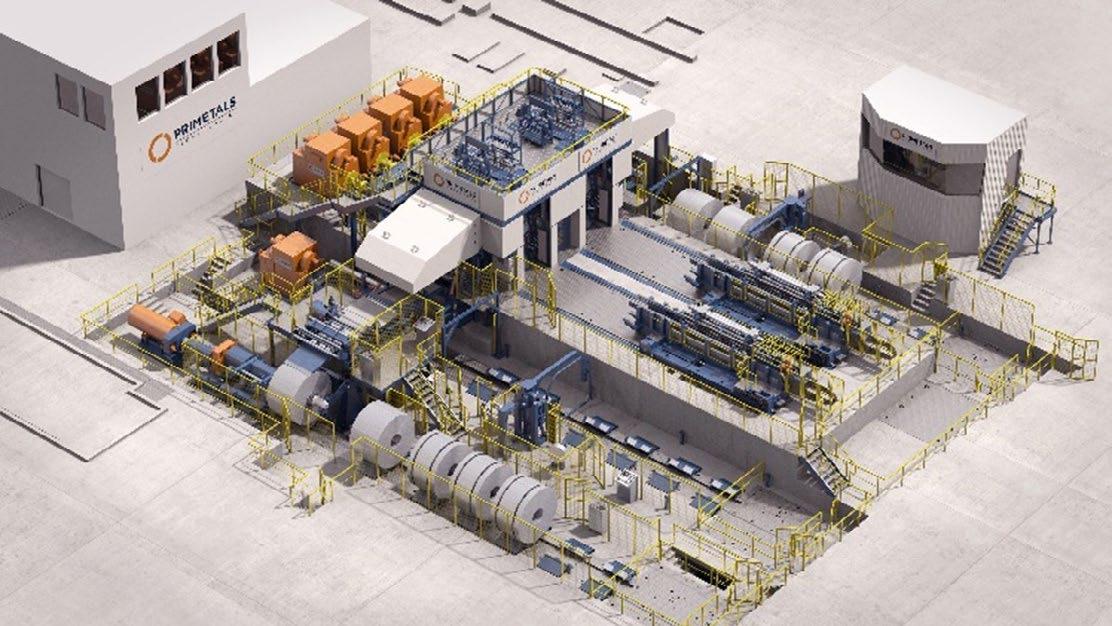
Work Roll Diameter Evolution
Fig. 7 shows a comparison of mill stand technologies with different ratios of work roll diameter to maximum strip width. While for a classical 4-high mill, this ratio is typically around 30% to 40%, a 6-high UC-Mill shows a ratio of around 25%. The HYPER UC-Mill utilizes even smaller diameter work rolls and shows a ratio of about 20% keeping the benefits of the standard UC-Mill mill including work roll drive and is therefore ideally suited for rolling AHSS and high-Si NGO electrical steel. Primetals Technologies’ convertible mill Flex-HI® with its 18high mode and a ratio of about 10% offers an extended reduction capability to produce high-strength steels down to ultra-low gauge, while keeping the high productivity in its classical 4-high mode (cf. [6]). On the very right in
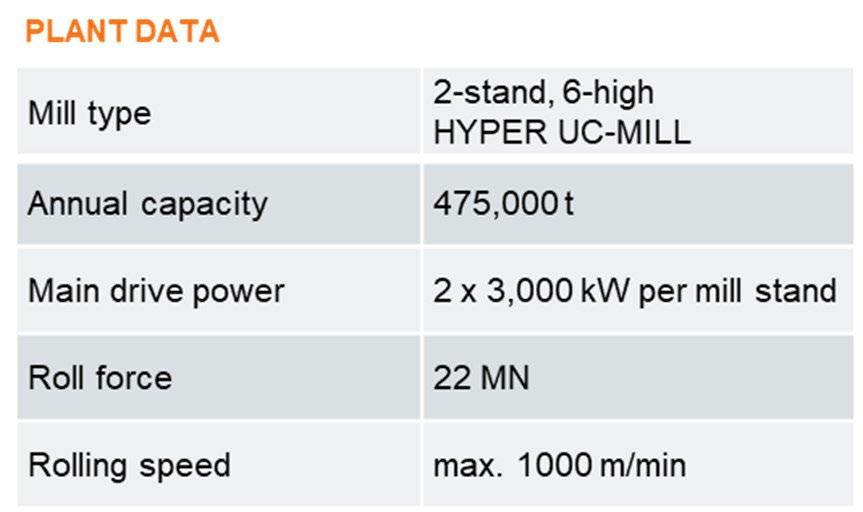
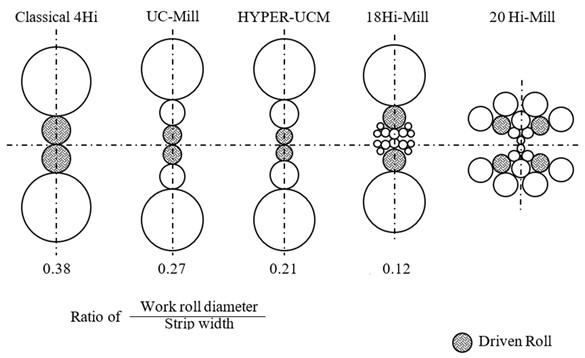
Fig. 7, 20 Hi-Mills (e.g. HZ-mills) utilize a minimum work roll diameter to offer rolling capability to produce GO electrical steels and ultra-thin and hard products.
Fig.7 - Comparison of different mill types and work roll diameters.
Tandem Cold Rolling Mill Configuration
A typical configuration for continuous tandem cold mill for rolling AHSS and high-grade non-grain-oriented electrical steel sheets is depicted in Fig. 8.
Fig.8 - Typical configuration of tandem cold mill for high productivity AHSS and electrical steel production.

This mill configuration utilizes a strip induction heater in front of the tandem mill and an additional bridle roll unit between tandem mill and tension reel, which allows to increase strip tension in later stands.
Benefits of continuous rolling operation compared to batch operation:
• Productivity increase
• Yield increase
• Product quality improvement
• Reduction of production costs (electricity, roll consumption, oil consumption, maintenance costs, etc.)
• Personal costs
• Reduced production time
Strip Heating Prior To Cold Rolling
Cold rolling of high-silicon electrical steel (Si ≥ 2.5%) is characterized by an increased risk of strip breaks. The main reason is due to the high brittleness of high-Si steels at typical cold rolling temperatures. The high brittleness of the strip material in combination with high rolling loads
(strip tension, contact pressure and shear stresses in the roll bite) during cold rolling can lead to generation and growth of edge cracks which can lead to strip breaks and significant production downtimes and delays.
It is known that the strip material brittleness can be significantly reduced by increasing the strip temperature before cold rolling (cf. e.g. [1]). The strip temperature at the entry of a tandem mill is typically at room temperature (e.g. 20 to 30°C). The room temperature brittleness also depends on the silicon and aluminum content of the strip material. Higher Si-content (≥ 2.5%) and Al-content (≥ 0.5%) can lead to increased room temperature brittleness and consequently reduced ductility and formability during cold rolling. The reason for generated edge cracks is a prevented dislocation sliding, which leads under applied rolling loads to an unwanted twinning effect of the metal structure.
Fig.9 shows a ductile-to-brittle transition temperature diagram (DBTT), which was determined by a servohydraulic high speed testing machine (cf. [1]). The depicted DBTT is for 3.4% Si non-grain oriented (NGO) electrical steel considering different deformation (strain) rates. At typically high deformation rates (cf. blue curve at 100 s-1 in Fig.9) for cold rolling, the ductile-to-brittle transition temperature occurs in this case approximately at room temperature (here 22°C).
This means that cold rolling at room temperature represents a significant risk for strip breaks, because of the reduced fracture elongation and high brittleness of the strip material. Reducing the deformation rate, i.e. reducing the strip speed and/or reduction, or increasing the strip temperature improves the ductility, formability and hence reduces the risk for edge crack propagation and strip breaks significantly.
Fig.9 - Ductile-to-brittle transition temperature (DBTT) for a 3.4% Si steel (source: [1]).
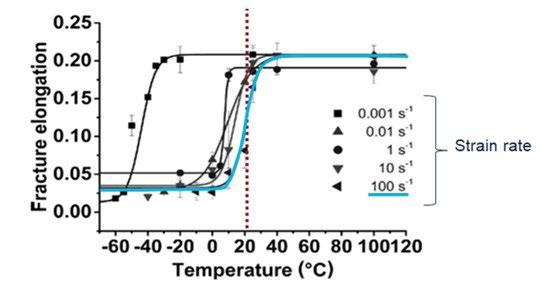
Strip Temperature Guidance
As explained above the strip temperature plays an important role for a stable and successful production of high-permeability electrical steels, especially during threading and first pass rolling. An increased strip temperature may in this regard also be beneficial for the second and later rolling passes. This can be accomplished by a controlled strip temperature guidance through the whole tandem mill resp. reversing pass journey. If the strip temperature gets too low, a distinctive brittleness of the material together with actual applied rolling loads may result in edge cracks and strip breaks. On the other hand, a too high strip temperature can lead to increased work roll temperatures and reduced hardness of the work roll shell material, which can lead for examples to heat streaks or other surface defects.
Therefore, a product-based guidance of the strip temperature may be beneficial. Actuators to influence and control strip temperatures are strip cooling, work roll cooling, strip speed, rolling pass distribution, induction heating and others.
An advanced strip temperature model significantly improves the setup and control of the strip temperature guidance (STG) and considers the special and difficult deformation behavior of high-Si electrical steels. Fig.10 shows an example of strip temperature evolution in a 5-stand tandem mill with prior inductive strip heating. As one can see, the emulsion lubrication on entry side of stand 1 decreases the prior heated-up strip undesirably, leading to energy waste and costly processing of electrical steels.
Minimum Quantity Lubrication (MQL, cf. [4]) can avoid the undesired strip temperature drop before the first pass, because entry side lubrication is done with pure rolling oil atomized with air and sprayed directly onto the surface of the work rolls. This ensures that the strip temperature is not affected by the roll-gap lubrication as it is the case for conventional recirculation emulsion lubrication.
Fig.10 - Example of strip temperature evolution in a tandem mill with prior strip heating.
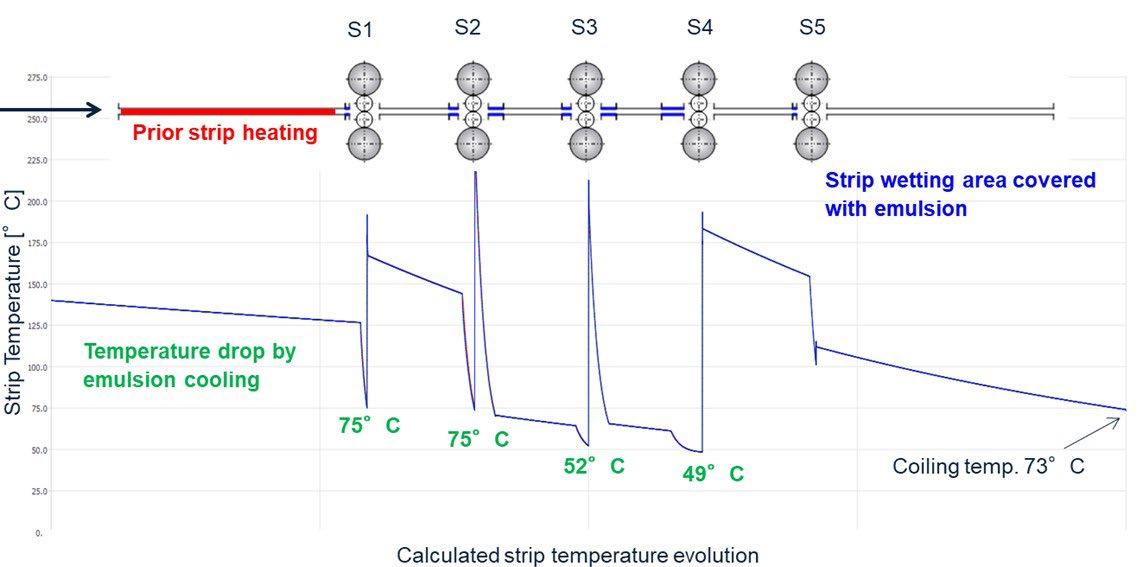
Conclusion
This paper describes latest mill stand technologies and innovations to support a successful and stable production of AHSS and thin-gauge high-grade NGO electrical steels.
Classical 4-high cold rolling mills have known technical limitations in terms of reduction capability to roll hard and thin materials, due to its large contact length between work roll and strip caused by large work roll diameters and excessive work roll flattening under the high rolling forces involved.
The “HYPER UC-MILL®” is a new generation of 6-high cold mill with reduced work roll diameters, work roll drive and still high torque transmission capability. This technology is not only today’s role model for new tandem and reversing mills, but also an affordable solution for mill revamps. Its excellent reduction and shape control capability combined with reduced edge loads and straight roll inventory make the HYPER UC-MILL the perfect solution to produce high-strength steels and thin-gauge cold rolled products.
Additional new features like strip temperature guidance (STG) and edge-drop control (EDC) support a stable and reliable production of high-grade electrical steels with low waste and high yield.
References
[1] J. Kwon, H. Huh, and J. Kim (2017), ‘Evaluation of the Ductile-to-Brittle Transition Temperature of a Silicon Steel Under Various Strain Rate Conditions With a Servo-Hydraulic High Speed Testing Machine’, Met. Mater. Int., vol. 23, no. 4, pp. 736–744
[2] D. Hikino, Y. Nakajima, I. Nakayama, S. Yasunari (2017), Newly developed universal crown control mill “HYPER UCM” for rolling of high-hardness and thinner steel, 3rd European Steel and Technology and Application Days, Vienna, Austria, June 26-29, 2017
[3] R. Kopp, H. Wiegels (1998), Einführung in die Umformtechnik, Verlag der Augustinusbuchhandlung Aachen
[4] M. Bergmann, K. Krimpelstaetter, B. Nilsson, S. Karakavaf, R. Leffers (2019), Intelligent roll-gap lubrication improves strip surface cleanliness in thyssenkrupp steel’s tandem cold rolling mill, 4th European steel technology and application days ESTAD 2019, Duesseldorf, Germany, June 24-28, 2019
[5] V. Ginzburg (1989), Steel-Rolling Technology: Theory and Practice, Taylor & Francis Inc
[6] K. Krimpelstaetter, S. Angerer, B. Schinagl (2022), Flexible cassette makes traditional cold mills fit for future steel grades, 12th International Rolling Conference, Trieste, Italy, October 26-28, 2022
[7] A. Böttcher (2022), Electrical steel becoming short in the future, IESSS 2022, Aachen, Germany, April 26-27, 2022






